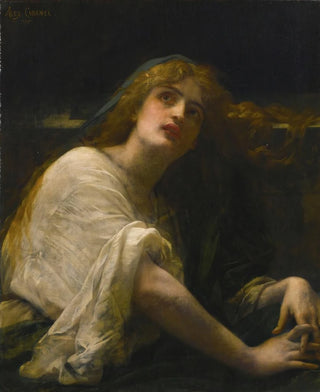Painting Marie-Madeleine au tombeau - Alexandre Cabanel | Art print


View from behind

Frame (optional)
In the fascinating world of 19th-century academic painting, Alexandre Cabanel's art print, "Marie-Madeleine au tombeau," stands out for its emotional depth and striking beauty. This canvas, emblematic of the artist's technical virtuosity, transports us to the heart of a moment of spiritual revelation. The scene depicts Marie-Madeleine, an iconic figure of Christianity, in a moment of contemplation and despair before Christ's empty tomb. The choice of this subject, imbued with mystery and sacredness, invites the viewer to reflect on faith, loss, and redemption.
Style and uniqueness of the piece
Cabanel, master of chiaroscuro, uses light to emphasize the contours of Marie-Madeleine's body, creating a striking contrast between shadow and light. The chosen color palette, dominated by warm tones and flesh nuances, gives the work an atmosphere that is both gentle and tragic. The delicacy of Marie-Madeleine's features, her expression filled with melancholy, testifies to a rare artistic sensitivity. The composition, carefully orchestrated, guides the viewer's gaze toward the protagonist's face, while incorporating decorative elements that enrich the visual narrative. Every detail, from sumptuous drapery to subtle reflections on the skin, reveals Cabanel's exceptional craftsmanship and his commitment to poetic realism.
The artist and his influence
Alexandre Cabanel, born in 1823 in Montpellier, is one of the most representative artists of the French academic movement. His career, marked by success and distinctions, allowed him to establish his style in a rapidly changing art world. Influenced by the Renaissance and Baroque masters, Cabanel managed to marry tradition and modernity. His art print "Marie-Madeleine au tombeau" perfectly illustrates this duality, combining impeccable technique with a profound emotional approach. The artist also left his mark through his teaching, training many students who, in turn, contributed to the evolution of painting. His impact endures, and his work continues to inspire generations of art lovers.

Matte finish

View from behind

Frame (optional)
In the fascinating world of 19th-century academic painting, Alexandre Cabanel's art print, "Marie-Madeleine au tombeau," stands out for its emotional depth and striking beauty. This canvas, emblematic of the artist's technical virtuosity, transports us to the heart of a moment of spiritual revelation. The scene depicts Marie-Madeleine, an iconic figure of Christianity, in a moment of contemplation and despair before Christ's empty tomb. The choice of this subject, imbued with mystery and sacredness, invites the viewer to reflect on faith, loss, and redemption.
Style and uniqueness of the piece
Cabanel, master of chiaroscuro, uses light to emphasize the contours of Marie-Madeleine's body, creating a striking contrast between shadow and light. The chosen color palette, dominated by warm tones and flesh nuances, gives the work an atmosphere that is both gentle and tragic. The delicacy of Marie-Madeleine's features, her expression filled with melancholy, testifies to a rare artistic sensitivity. The composition, carefully orchestrated, guides the viewer's gaze toward the protagonist's face, while incorporating decorative elements that enrich the visual narrative. Every detail, from sumptuous drapery to subtle reflections on the skin, reveals Cabanel's exceptional craftsmanship and his commitment to poetic realism.
The artist and his influence
Alexandre Cabanel, born in 1823 in Montpellier, is one of the most representative artists of the French academic movement. His career, marked by success and distinctions, allowed him to establish his style in a rapidly changing art world. Influenced by the Renaissance and Baroque masters, Cabanel managed to marry tradition and modernity. His art print "Marie-Madeleine au tombeau" perfectly illustrates this duality, combining impeccable technique with a profound emotional approach. The artist also left his mark through his teaching, training many students who, in turn, contributed to the evolution of painting. His impact endures, and his work continues to inspire generations of art lovers.
12,34 €






